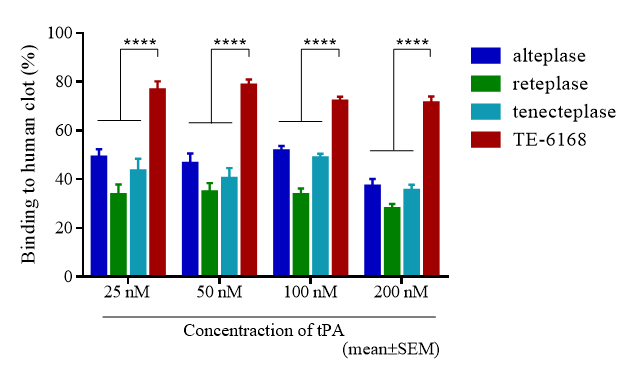
TE-6168 is a one-polypeptide fusion protein composed of an anti-fibrin scFv and a molecule of reteplase. The scFv moiety can bind to blood clots (containing fibrin) without being interfered by high concentrations of fibrinogen, and the reteplase, which contains the protease domain of human tissue plasminogen activator (tPA), can dissolve clots.
The design of TE-6168 does not involve using a multi-arm linker. However, it adopts the broad concept of “T-E pharmaceuticals”.
It is hoped that TE-6168 can dissolve blood clots more efficiently in ischemic stroke, myocardial infarction, and other conditions of pathological blood clot formation, while leaving fewer episodes of internal bleeding, than other tPA forms.
Experiments with in vitro and in vivo mouse and rat models have demonstrated better clot-targeting effects, thrombolytic activities, and stroke recovery efficacy, while causing milder side effects leading to internal bleeding, than alteplase, reteplase, and tenecteplase.

The molecular structure of TE-6168, a one-polypeptide fusion protein.

TE-6168 has a stronger binding activity to human clots than alteplase, reteplase and tenecteplase. (ANOVA with Tukey's multiple comparison tests, **** p<0.0001)

The effects of TE-6168 and other tPAs on the behavior scores before treatment and 24 hours after clot implantation in rat middle cerebral artery occlusion (MCAO) stroke model. The tPAs were given i.v. bolus 2 hours after stroke induction. Behavior scores were measured before tPA treatment and 24 hours after stroke induction. After behavior score measurements at 24 hours were made, rats were sacrificed and their infarct volume in the brain were measured. The results demonstrated better thrombolytic activities and stroke recovery efficacy than other tPAs. B: before treatment, A: 24 hours after MCAO. Data are presented as mean ± S.E.M. and were analyzed using Holm-Šídák multiple comparisons test. ** p<0.005, *** p<0.0005, ¶ p=0.9983, § p=0.992.

TE-6168 does not increase the BBB permeability following MCAO in rates. Evans blue dye was used to evaluate the BBB permeability in vivo. The BBB permeability of the rats treated with TE-6168 was significantly lower than that treated with reteplase or tenecteplase after MCAO 3 hours. Data are presented as mean ± S.E.M. and analyzed using Holm-Šídák multiple comparisons test. *** p<0.0005, ¶ p<0.9999, § p=0.3311.

